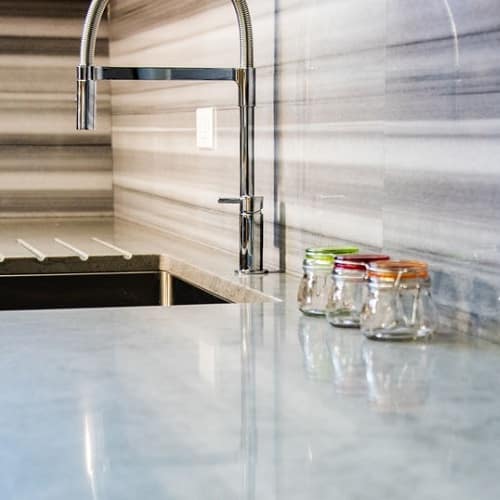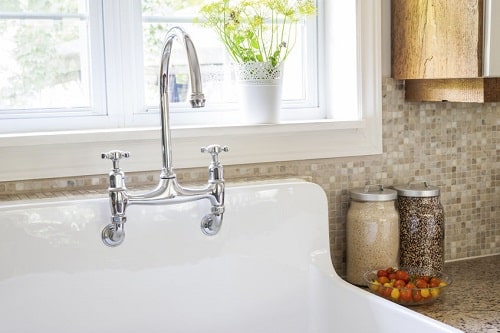Granite backsplashes are a timeless choice for homeowners seeking a combination of durability, functionality, and elegance. Acting as a protective barrier between your walls and countertop, granite backsplashes shield against moisture, stains, and everyday splashes while elevating your kitchen or bathroom’s aesthetic appeal. Whether you’re pursuing a cohesive high-end design or a practical solution, granite offers the perfect balance of beauty and utility. Let’s dive into what makes granite backsplashes a standout option and explore how they can transform your space.

Choosing a Design That Fits Your Style
Selecting the right backsplash design is a pivotal part of your kitchen or bathroom’s overall look. While a backsplash may seem like a small detail, it plays a critical role in tying the space together and protecting your walls from damage. Granite backsplashes, with their rich colors and natural veining, add sophistication and a unique touch to any room.
Granite is available in a wide range of hues and patterns, from subtle neutrals like whites and grays to bolder options with dramatic veining or flecks of color. These variations ensure that no two granite slabs are identical, giving your kitchen or bathroom a personalized look. Whether your style leans traditional, modern, or somewhere in between, there’s a granite backsplash to complement your vision.
Granite Backsplash or Tile?
When choosing a backsplash material, granite and tile are two of the most popular options. Each has its advantages, but granite often stands out for its durability and low maintenance.
Granite Backsplashes
- Durability: Granite is one of the hardest natural stones, making it resistant to scratches, dents, and heat.
- Low Maintenance: Unlike tile, granite has no grout lines to clean or maintain. A quick wipe with a damp cloth is all it takes to keep it looking pristine.
- Seamless Look: A granite backsplash, especially when paired with matching countertops, creates a cohesive and luxurious design.
Tile Backsplashes
- Design Flexibility: Tiles come in countless shapes, colors, and patterns, offering more customization options than granite.
- Budget-Friendly: Tile is often a more affordable option upfront, but the cost of ongoing grout maintenance can add up over time.
While tile can be a great option for homeowners seeking intricate patterns or bold color combinations, granite’s durability and elegance make it a top choice for those looking for a long-lasting solution.
Should You Have a Granite Backsplash?
Benefits of Granite Backsplashes
- Longevity: Granite is built to last, often outliving the kitchen or bathroom itself. With proper care, it can maintain its beauty for decades.
- Hygienic Surface: Granite’s smooth, sealed surface resists bacteria and moisture, making it a hygienic choice for kitchens and bathrooms.
- Heat Resistance: Unlike some materials, granite won’t warp or discolor when exposed to high heat, making it ideal for areas near stoves or ovens.
- Versatility: Granite’s neutral tones and intricate patterns work well with various design styles, from rustic to contemporary.
Drawbacks to Consider
- Higher Cost: Granite is generally more expensive than materials like ceramic tile, especially for full-height backsplashes.
- Heavier Material: Its weight requires professional installation, which can increase labor costs.
How Much Does a Granite Backsplash Cost?
The cost of a granite backsplash depends on the quality of the stone and the size of the installation. On average:
- 4-Inch Granite Backsplash: A standard backsplash that covers just the area directly above the countertop usually costs between $50 and $100 per linear foot, including installation.
- Full-Height Granite Backsplash: Extending the backsplash to the base of the cabinets or ceiling increases the material and labor costs, often ranging from $1,200 to $3,000 depending on the size of your space.
To save on costs, some homeowners opt for granite remnants, which are leftover pieces from larger projects. These can be a budget-friendly way to achieve a high-end look without breaking the bank.
How Far Up Should a Kitchen Backsplash Go?
The height of your backsplash is a matter of personal preference and design goals. Here are the most common options:
4-Inch Backsplash
This traditional height provides basic protection against spills and splashes while leaving the upper walls open for paint, wallpaper, or additional design elements. It’s a practical and budget-friendly choice.
Full-Height Backsplash
For a more dramatic and cohesive look, many homeowners choose to extend their backsplash from the countertop to the base of the cabinets or even the ceiling. This design eliminates the need for additional wall treatments and creates a seamless, luxurious appearance.
Accent Areas
If a full-height backsplash isn’t in your budget, consider installing it in key areas like behind the stove or sink. This approach balances functionality and cost while adding visual interest to your kitchen.

Backsplash Installation Tips
Should You Install Countertops or Backsplashes First?
Always install countertops before adding a backsplash. The countertop serves as the foundation for the backsplash, ensuring precise alignment and a clean, finished look.
How Long Does It Take to Install a Granite Backsplash?
- 4-Inch Backsplash: Installation typically takes just a few hours, as it involves minimal cutting and fitting.
- Full-Height Backsplash: A larger installation may take 2–3 days, depending on the complexity of the design and the number of cuts required.
Caring for Your Granite Backsplash
To keep your granite backsplash looking its best:
- Clean Daily: Use a soft cloth and mild soap to wipe away spills and splashes.
- Avoid Harsh Cleaners: Acidic or abrasive cleaners can damage the sealant and dull the surface.
- Seal Regularly: Reapply a granite sealer every 1–2 years to maintain its stain resistance and luster.
A granite backsplash is more than just a protective barrier—it’s a statement piece that adds elegance and functionality to your kitchen or bathroom. Whether you’re pairing it with matching countertops or using it as a standalone feature, granite offers a timeless appeal that enhances the value and beauty of your home.
Ready to transform your kitchen or bathroom with a stunning granite backsplash? Contact Wholesale Granite Direct today at 817-962-2616 in Arlington or 817-710-8604 in Granbury. Let us help you create a space that’s both practical and breathtaking!

